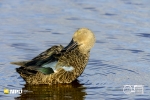
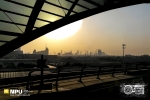
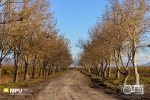



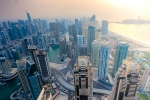


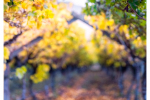

My wife Dominique and I had the privilege of spending 8 days in Zanzibar. We stayed on the Unguja Island, based ourselves on the northern tip in Nungwi. Our stay was at the DoubleTree Resort by Hilton Hotel Zanzibar – Nungwi, where we were very well looked after by our host Shaun.
Everyone dreams of an “island-in-the-sun” holiday or destination, and most people walk away with palm trees, cocktails on the beach images, I had this in mind too; however, from the outset, wanted to shoot the Milky Way over Zanzibar, capture the raw grittiness of the streets, life, historic buildings, convey the essence and pulse of life as it is in Zanzibar and Stone Town; to be able to tell this story in captivating colour and monochrome as well.
On doing some research, I found only three other photographers that had actually done photographed the Milky Way! I wanted this travel shoot to be a special Zanzibar photo shoot, something different and unique…my objectives were achieved!
If you select satellite map, you’ll soon see a wide turquoise-blue strip which lines Zanzibar’s East Coast: this is the shallow-water between the land and the coastal barrier reef. Given that the tide retreats almost to the reef in many parts of the East Coast – this map shows how far the tide goes, and so why it’s not always possible to swim on these beaches.
[google-map-v3 shortcodeid=”1fc9938282″ width=”100%” height=”400″ zoom=”10″ maptype=”roadmap” mapalign=”center” directionhint=”true” language=”default” poweredby=”false” maptypecontrol=”true” pancontrol=”true” zoomcontrol=”true” scalecontrol=”true” streetviewcontrol=”true” scrollwheelcontrol=”true” draggable=”true” tiltfourtyfive=”true” enablegeolocationmarker=”true” enablemarkerclustering=”false” addmarkermashup=”false” addmarkermashupbubble=”false” addmarkerlist=”Nungwi, Zanzibar{}house.png{}Zanzibar|Stonetown, Zanzibar{}photography.png{}Zanzibar” bubbleautopan=”true” distanceunits=”km” showbike=”true” showtraffic=”true” showpanoramio=”true”]
The general impression of Zanzibar when approached from the mainland is of a long, low island with small ridges along its central north–south axis. Coconut palms and other vegetation cover the land surface. It is 85km at its greatest length and 39km broad. The highest point of the central ridge system is Masingini, 119m above sea level. Higher ground is gently undulating and gives rise to a few small rivers, which flow west to the sea or disappear in the coral country.
The climate is typically insular, tropical, and humid, with an average annual rainfall of 1500 to 2000 mm. Rainfall is reliable and well-distributed in comparison with most of eastern Africa. Northeast trade winds blow from December to March and southeast trade winds from May to October. The “long rains” occur between March and May and the “short rains” between October and December. At the present moment, Mango offers flights from Johannesburg to Zanzibar City.
The small tropical island of Zanzibar, a mere twenty miles off the east coast of Africa, has played a major part in local history, out of all proportion to its size. The reason is, its easy access to traders and adventurers exploring down the east coast of Africa from Arabia. Islam was well established in this region by the 11th century.
During the 16th century there was a new category of visitor arriving from the south – the Portuguese. They establish friendly relations with the ruler. By the end of the century there was a Portuguese trading station and a mission run by Augustinian friars. But in the late 17th century the Christian presence comes to an end, after a forceful campaign down the coast by the Muslims of Oman.
In the 1690s Saif bin Sultan, the imam of Oman, is pressing down the East African coast. A major obstacle is Fort Jesus, housing the garrison of a Portuguese settlement at Mombasa. After a two-year siege, it falls to Saif in 1698. Thereafter the Omanis easily eject the Portuguese from Zanzibar and from all other coastal regions north of Mozambique.
Zanzibar, a valuable property as the main slave market of the East African coast, becomes an increasingly important part of the Omani empire – a fact reflected by the decision of the greatest 19th-century sultan of Oman, Sa’id ibn Sultan, to make it from 1837 his main place of residence.
Sa’id builds impressive palaces and gardens in Zanzibar. He improves the island’s economy by introducing cloves, sugar and indigo (though at the same time he accepts a financial loss in co-operating with British attempts to end Zanzibar’s slave trade).
The link with Oman is broken after his death in 1856. Rivalry between his two sons is resolved, with the help of forceful British diplomacy, when one of them (Majid) succeeds to Zanzibar and to the many regions claimed by the family on the east African coast. The other (Thuwaini) inherits Muscat and Oman.
By the time Majid inherits the throne in Zanzibar, the British are increasingly involved in this prosperous offshore island. In this same year, 1856, Burton and Speke make this the base for their exploration into the interior. Their route towards Lake Tanganyika is along the tracks frequented by Arab traders, through territory which the Omani sultans of Zanzibar claim as their own.
By the time Majid dies, to be succeeded in 1870 by his brother Barghash, the British have appointed a consul to Zanzibar. His primary task is to end Zanzibar’s notorious slave trade. This purpose is achieved by a treaty with Barghash in 1873.
The consul who achieves this treaty is John Kirk. It is poignant for him that this is the year in which he does so. For it is also the year in which David Livingstone, the great anti-slavery explorer, dies in the African interior. His embalmed corpse is carried by his assistants all the way back to Zanzibar.
Kirk, who receives Livingstone’s body in his role as consul, has been an intimate friend. For five years, from 1858 to 1863, he accompanied all Livingstone’s expeditions in the role of doctor and naturalist. He too has witnessed at first hand the brutal activities of the Arab slave traders in the interior. Livingstone would be pleased to know that their main market is now closed to them.
Well aware that Zanzibar needs to replace slave revenue with legitimate economic activity, Kirk is assiduous in encouraging Barghash to build up the export of rubber and ivory – brought from the interior of the continent, where the sultan wields a somewhat loose and ramshackle authority through Tabora and on to Ujiji.
By the mid-1880s the sultan is earning a fortune from these sources, but Kirk proves powerless to protect him from a new threat. In 1884-5 there are reports of a German, Karl Peters, snooping around the caravan routes to the Great Lakes. In March 1885 there comes the astonishing news that Germany is claiming a protectorate in this inland region. And in August there is an alarming sight from the verandah of the palace.
On 7 August 1885 five German warships steam into the lagoon of Zanzibar and train their guns on the sultan’s palace. They have arrived with a demand from Bismarck that Sultan Barghash cede to the German emperor his mainland territories or face the consequences.
But in the age of the telegram, gunboat diplomacy is no longer a local matter. This crisis is immediately on desks in London. Britain, eager not to offend Germany, suggests a compromise. The two nations should mutually agree spheres of interest over the territory stretching inland to the Great Lakes. This plan is accepted before August is out.
The embarrassed British consul finds himself under orders from London to persuade the sultan to sign an agreement ceding the lion’s share of his mainland territory, with the details still to be decided. In September the German gunships begin their journey home. A joint Anglo-German boundary commission starts work in the interior.
By November 1886 the task is done and the result is agreed with the other main colonial power, France. The sultan is left a strip ten miles wide along the coast. Behind that a line is drawn to Mount Kilimanjaro and on to Lake Victoria at latitude 1° S. The British sphere of influence is to be to the north, the German to the south. The line remains to this day the border between Kenya and Tanzania.
After the abrupt redistribution of the sultan’s inland territories, Britain remains the only colonial power with a well-established presence in Zanzibar itself. With the approval of the sultan the island and its narrow coastal regions are declared a British protectorate in 1890.
Although only wielding a fraction of their former power, the Arab sultans of Zanzibar are still during this colonial period the most influential Muslim leaders in east Africa. But their rule comes to an end soon after the island’s independence in the 1960s.
A new constitution, introduced in 1960, provides for a legislative assembly. The emerging political parties are split largely on ethnic lines, representing Arab and African interests respectively, and disagreement about the franchise delays the introduction of internal self-government until June 1963. It is followed in December by full independence and membership of the British Commonwealth.
A coalition of Arab parties forms the first government, with the sultan as head of state. But in January 1964, a month after independence, a communist-led revolution topples the regime. The sultan is deposed and a republic proclaimed.
The revolution, carried out by not more than 600 insurgents, involves considerable acts of violence against the Arab and Indian populations of the island – most of whom make a hasty departure.
Abeid Amane Karume emerges as president of the resulting one-party state. His first step is to negotiate for union with neighbouring Tanganyika, also left-wing in its policies though not Marxist. The two nations are merged in April 1964, becoming the United Republic of Tanzania, with Nyerere as president and Karume as vice-president. But Zanzibar retains its revolutionary council and often continues to go its own way, to the discomfiture of the government in Dar es Salaam.
Nungwi is traditionally the centre of Zanzibar’s dhow-building industry, and, over the last decade, the coastline here has rocketed in popularity to become one of the island’s busiest beach destinations. The ramshackle fishing village has been side-lined by an ever-increasing number of guesthouses, bars, shops, restaurants and bikini-clad backpackers. Ageing hippies, cool dudes, gap-year students and bright young things escaping European city jobs are all drawn to its white sand, stage-set palm trees, turquoise sea and sparkling sunshine. The setting is beautiful, but the number of people, constant buzz and locals persistent haggling for an income off of tourists, can take the edge off its charm.
By day, the beach sees sunbathing tourists slumber, swim and indulge in lemongrass massages, whilst wandering local guys tout their ‘tours’ and sell a range of mediocre paintings, sunglasses and replica football shirts; then, as the sun sets, the visitors arise and the whole place buzzes with party spirit. Beach bonfires blaze, cocktails flow and the music rocks till late, all provided by locals at the various hotels.
Despite the influx of tourists, Nungwi is a traditional, conservative place. It was one of the last coastal settlements on Zanzibar to have a hotel, or any tourist facilities. As recently as the mid-1990s, proposals for large developments in the area were fiercely opposed by local people. Today, the proudly independent villagers give the impression that tourists are here on sufferance. However, they are not unfriendly and most visitors find that a little bit of cultural respect, politeness and a few words of Swahili go a long way.
Some visitors, particularly backpackers, find themselves torn between either coming to Nungwi and the north coast, or going to Paje, Bwejuu and Jambiani on the east coast. For some thoughts on the differences between these two areas see.
The sweeping cape on which Nungwi is situated is surrounded by sparkling, warm, turquoise seas, making it a perfect spot to engage in countless water activities. As well as being a tourist destination, Nungwi is also the centre of Zanzibar’s traditional dhow-building industry. A number of hardwood trees, particularly good for boats, grow in this area (or at least did grow here, until they were chopped down to make into boats). Generations of skilled craftsmen have worked on the beach outside the village, turning planks of wood into strong ocean-going vessels, using only the simplest of tools.
It is a fascinating place to see dhows in various stages of construction, but do show respect for the builders, who are generally indifferent towards visitors, and keep out of the way. Most do not like having their photos taken (ask before you use your camera), although a few have realised that being photogenic has a value, and will reasonably ask for payment.
Fishing continues to employ many local men, and it’s magical to watch the local fishing boats bobbing in the sparkling waves of the morning, and then set out to sea in the late afternoon. There can be as many as 40 going out at once, their distinctive lateen sails silhouetted against the blush evening sky – it’s probably been unchanged for centuries. Early in the morning, around 06h00, they return with their catch to the beach fish market. The spectacle is worth the early start, but if you don’t make it, there’s a smaller re-run at around 15h00 each day.
Like the east coast, Nungwi’s other key marine industry centres on its seaweed. Local women tend this newly introduced crop on the flat area between the beach and the low-tide mark. The seaweed is harvested, dried in the sun and sent to Zanzibar Town for export.
Nungwi afforded us some wonderful photographic opportunities to capture the Milky Way, boat builders in action and the endless beaches. The varying weather patterns allow for some seriously dramatic skies, the clouds sometimes have a greenish tinge to them, at first I thought this was error in my editing, but discovered this to be the norm. A guided walk through the village afforded some wonderful candid shots of children and adults, it did however cost a few US Dollars or local Tanzanian Shillings per shot or group shot, but was the only secure way of producing the goods. Being a Muslim culture, photography is an issue. Permission is a MUST! The only other way around this is to shoot from the hip and hope you get your shot, this must be done prudently or discreetly.
A visit to the local spice plantations near Kizimani was extremely informative! The Zanzibari idea of farming is nothing like the Western Mind has in mind. What appears like a jungle opens up before your eyes under your guides direction, from vanilla which has to be individually hand-pollinated as there are no bees to do the job, ylang-ylang, cardamon, ginger, pepper, cinnamon, lemongrass, nutmeg, cloves, fresh young coconut to quench your thirst, unusual citrus fruits, starfruit, jackfruit and even the iodine tree if you get injured all come to life when you begin to see with the Zanzibari eye. There is even the “lipstick” tree! The villager who climbs the coconut tree has to sing on his climb and decent, to warn others below (sometimes 20m or more high) that he is picking coconuts. A falling coconut will surely kill you if it falls on your head! We experienced a Zanzibari meal in the village using fresh spices and fruits we had just seen. Spices were also for sale after the tour, were we also had the chance to individually taste fresh fruits. Their hospitality was really special.
Another memorable event was a sunset cruise on a traditional dhow, using a small engine to get us to our furthest destination, the return was by wind and sail. There are many tour operators, either at the hotels or locals all looking to make a Dollar off the average 1 000 000 tourists that visit annually. Locals are quite happy to try sell you their wares; from bracelets, keyrings, henna tattoos to a village walk. Some guides are quite dodgy, others more reliable; in this case we used The Three Brothers on this sailing excursion. It was amazing to watch the boatman build the boats, they use cotton wedged between the beams of wood as glue, the wood gets wet, swells and compressors against the cotton, making a watertight seal. Actually sailing these boats was exciting! Their navigation skills have been passed down from generation to generation; they don’t use a compass or GPS! Our sunset cruise took us towards the islands of Popo and Tumbatu near Kendwa beach.
Zanzibar Town, on the western side of the island, is the heart of the archipelago, and the first stop for most travellers. It is divided into two halves by Creek Road, once a creek that separated Stone Town (Mji Mkongwe) from ‘The Other Side’ or Ng’ambo, where a small community of slaves once lived and which now accommodates the growing new city with its offices, apartment blocks and slums. During the colonial period, before the development of towns such as Dar es Salaam, Nairobi and Mombasa, Zanzibar Town was the largest settlement in the whole of east Africa.
The streets are, as they should be under such a sky, deep and winding alleys, hardly twenty feet broad, and travellers compare them to the threads of a tangled skein. Richard Burton, British explorer (1857)
If Zanzibar Town is the archipelago’s heart, Stone Town is its soul. Stone Town, was constructed during the 19th century and remains largely unchanged, it is also a UNESCO World Heritage site. Labyrinths of narrow alleys lead to palaces, mosques and old Arab houses; tiny shops sell dotted tinga-tinga paintings, Zanzibari clocks and heavily adorned chests. The early-morning market on Creek Road is fabulous, as determined Zanzibaris haggle over fragrant spices, exotic fruit and enormous fish. Walk through its alleyways overhung with wooden balconies and faces from every shore of the Indian Ocean and you’ll easily lose yourself in centuries of history, where different cultures collide. Each twist and turn brings something new, be it a school full of children chanting verses from the Quran, an abandoned Persian bathhouse or a coffee vendor with his long-spouted pot fastened over coals. Then there are the ghosts. Stone Town was host to one of the world’s last open slave markets and stories of barbaric cruelty still strike at the conscience.
While the best part of Stone Town is simply letting it unfold before you, it’s worth taking one of the recommended tours to really connect with local residents and appreciate its richly textured history.
It is the largest town in the archipelago as the being capital, Stone Town, located in the middle of the west coast of Unguja, the main island. The town was named for the coral stone buildings that were built there largely during the 19th century, on the site of a very old fishing village. There are over 16,000 people in the town today, and over 1,700 recorded buildings.
Tall houses line narrow alleyways set in a confusing maze radiating out from the centre towards the sea. The streets are too narrow for cars but not, unfortunately, for bicycles and even motorbikes, so be careful! Life is lived very much as it was in the past and the many mosques’ muezzin calls can be heard echoing above the narrow streets five times daily. The architecture is Arabic, which means the walls are very thick, the houses tall and with square and simple facades. Many of the buildings have a central courtyard going up through all the floors, giving ventilation, much like Old Dubai.
Zanzibar is well known for its infamous door carvings. Decoration has been added, usually by Indian craftsmen, in the form of wooden balconies and carved doors and stairways. Some of the doors have brass studs which originate in India, where they were used to protect buildings against elephants. The oldest, simplest and most traditional doors have horizontal lintels, as seen in Oman and Arabia generally; later doors have rounded tops and this style shows Indian design influence – many of the builders and craftsmen used in building Zanzibar were from the sub-continent. There are varying motifs in the carving: dates, fish, chains, flowers, lotus, Arabic texts and many more.
There are 51 mosques, whose muezzin cries vie with each other at prayer time, as well as 6 Hindu Temples and a Catholic as well as an Anglican Cathedral in this multi-ethnic town. There are many burial places around the outskirts, with interesting headstones and graves, and some important graves in the town itself, usually of religious leaders of the past.
On the waterfront, near the Old Dispensary, is an old Fig tree known locally as the Big Tree. It is quite visible from the harbour and is seen in many old photographs. The shaded area underneath it is currently used as a workshop for men building boats. It’s a good place to find boat pilots to charter a cruise to Prison Island or Bawe Island. Just opposite is a good beachfront restaurant, known as “Mercury’s”.
The second train in East Africa was completed in Zanzibar in 1905 and operated under the name of the Bububu line. It travelled from Bububu village to Stone Town, only 8 km away. It was used mostly for transporting people. Zanzibar was the first country in East Africa to introduce the steam locomotive. Sultan Bargash bin Said had a seven mile railway constructed from his palace at Stone Town to Chukwani in 1879. Initially the two Pullman cars were hauled by mules but in 1881 the Sultan ordered a 0-4-0 tank locomotive from the English locomotive builders Bagnall. The railway saw service until the Sultan died in 1888 when the track and locomotive were scrapped.
Fifteen years later (In 1905) the American Company Arnold Cheyney built a seven mile line from Zanzibar Town to the village of Bububu. It was notorious for its ability to set fire to property and the surrounding country side but it ran for twenty-five years until closed in 1930.
The Bububu Railway plied six or seven times a day to Zanzibar Town. The service was extremely popular and largely used by the native population. A special first-class coach was run for the benefit of those passengers from steamers who wish to obtain a glimpse of the island. The railway traversed some of the narrowest streets of the city, and it was a constant source of wonderment how passers-by escaped being run over. European residents in Zanzibar regard the railway with an amused tolerance.
During the railway construction the Americans undertook the task of installing electrical power lines along the track. Wherever the rails were placed, metal poles were installed and power lines strung overhead. By 1906, long before even London obtained them, Stone Town had electric street lights. In 1911, the railway was sold to the Government, and by 1922 the passenger service ceased. As roads improved and motor vehicles on the island increased, its popularity diminished.
With the improvement of the port the railway was used for the haulage of stone which was used to reclaim the seafront. Today much of the old track bed has been built on however train enthusiasts can still see the remains of the railway’s bridges and embankments close to the main road to Bububu.
Kiswahili is a language that developed along the East African Coast and incorporates words from all the nations around the Indian Ocean and the Arabian Gulf. It was originally written in Arabic script to spell the words phonetically, until Edward Steere, the Bishop who oversaw the building of the Anglican Cathedral on the site of the old slave market, wrote an English-Swahili dictionary in the Roman alphabet.
The slave trade created wealth which in turn led to the construction of palaces, mosques and many fine houses. Discovering the architectural gems hidden along the tortuous maze of narrow streets and alleyways that wind though Stone Town is part of the town’s magic and mystery for many visitors. Aside from the souvenir tinga-tinga painting and beaded jewellery, it’s a scene virtually unchanged since the mid-19th century, when it was described by Burton.
The best way to explore Stone Town is on foot, but the maze of lanes and alleys can be very disorientating. To help you get your bearings, it is useful to think of Stone Town as a triangle, bounded on two sides by sea, and along the third by Creek Road. If you get lost, it is always possible to aim in one direction until you reach the outer edge of the town where you should find a recognisable landmark.
Although most of the thoroughfares in Stone Town are too narrow for cars, when walking you should watch out for old bicycles and scooters being ridden around at breakneck speed! It’s also useful to realise that thoroughfares wide enough for cars are usually called roads while narrower ones are generally referred to as streets. Hence, you can drive along New Mkunazini Road or Kenyatta Road, but to visit a place on Kiponda Street or Mkunazini Street you have to walk. When looking for hotels or places of interest, you should also note that most areas of Stone Town are named after the main street in that area: the area being referred to as Kiponda Street or Malindi Street, instead of simply Kiponda or Malindi. This can be confusing, as you may not be on the street of that name. But don’t worry: at least you’re near!
Stone Town afforded us some wonderful photographic opportunities to capture the soul of the city, the lifeblood of the people and the pulse of life, in its eclectic East African way. There are two types of doors, those ordained with roses or flowers which are arched, are of Indian decent, the others are Arabic which are square shaped. This is a hallmark of the old city, the Zanzibari Doors. Another interesting observation was the water pipes of most buildings run outside the buildings along with the power supply all at the same height in a spider web maze; usually at first floor level. Very few buildings are painted smartly, I had to ponder upon this; one of the most feasible answers were the regular rain showers that are to be had, when would the paint dry? There are many things to see either in the town or a trip on a dhow will find you on a small island – Prison Island (Changu) where the slaves were quarantined prior to being shipped off.
The Cathedral was under renovation and repair, there were limited photographic opportunities there due to that. Constructed in the 1870s by the Universities’ Mission to Central Africa (UMCA), this was the first Anglican cathedral in East Africa. It was built on the site of the old slave market, the altar reputedly marking the spot of the whipping tree where slaves were lashed with a stinging branch. It’s a moving sight, remembered by a white marble circle surrounded by red to symbolise the blood of the slaves.
The driving force behind the construction of the cathedral was Bishop Edward Steere (1874–82), but the inspiration was David Livingstone, whose call to compassion the missionaries answered in 1864 when they settled on the island. One of the stained-glass windows is dedicated to his memory, while the crucifix is made from the tree that grew where his heart was buried in the village of Chitambo in Zambia.
Services are still held at the cathedral on Sunday mornings, although at the time of our visit, the cathedral was being restored.
The slave holding cells or chambers are a reality, and a macabre reminder of the hardships and horrible atrocities they had to endure under their masters. Although nothing of the old slave market remains, some 15 holding cells are located beneath the Anglican Cathedral and St Monica’s Hostel. Two of them, beneath St Monica’s, are open to the public and offer a sobering glimpse of the appalling realities of the trade. Dank, dark and cramped, each chamber housed up to 65 slaves awaiting sale. Tiny windows cast weak shafts of sunlight into the gloom and it’s hard to breathe even when they’re empty. There is barely sufficient head room to be seated in a foetal position in these chambers.
The Slave Memorial in the garden was sculptured by Swedish artist Clara Sornas in 1997-1998, which depicts five slaves standing in a pit below ground level. The poignant figures emerge from the rough-hewn rock and thus appear hopelessly trapped, shoulders slumped in despair. Around their necks they wear metal collars from which a chain binds them. It’s a disturbing and haunting sight. The mood and brokenness, vacant and empty, sunken stares of the five slaves is well captured and cast in stone, this can be easily seen at the monument besides the Cathedral.
A few places of interest to visit are the House of Wonders, Freddie Mercury House, Slave Market and the Darajani Market where spices, foods, meat and fish can be bought. No matter where you travel, one of the best ways to experience local life is to explore the local fresh market. Located just on the edge of the ancient lanes of Stone Town is Darajani Market, one of the central markets in Zanzibar. Markets are not only where things are sold and traded, but they are also where people congregate to socialize, meet friends, and eat. Though the market sprawls outside of the main building and throughout the surrounding lanes and side streets, the original building (pictured) that houses the small indoor section was built in 1904. The meat section, which mostly includes beef and goat, is not the best smelling place in the market, but you should definitely take a quick stroll through it; there are plenty of flies around, I would also say a strong stomach is needed for the queasy visitor. A plethora of fish is also to be found, many types, I did not recognise. If you fortunate enough, when the fish lands, you can witness a fish sale or auction. Fish are auctioned in loud voices in their respective areas. It’s hot, heaving and entertaining. Photographing under the market canopy can be quite challenging, as the light conditions are difficult, often a filtered light or colour cast is thrown, as the locals use various canvases to provide shade and relief from the tropical climate.
It is also quite challenging to capture images of the locals in the tight busy market, best done discreetly, and or with permission, I recommend a zoom lens for this task.
The House of Wonders or Palace of Wonders is a landmark building in Stone Town, Zanzibar. It is the largest and tallest building of Stone Town and occupies a prominent place facing the Forodhani Gardens on the old town’s seafront, in Mizingani Road. This large, white building dominates the waterfront area of Zanzibar Town, and is one of its best-known landmarks. A perfect rectangle, it is one of the largest buildings on the island even today, rising over several storeys, surrounded by tiers of pillars and balconies, and topped by a large clock tower. After more than a century of use as a palace and government offices, it opened in 2002 as the Museum of History and Culture and contains some fascinating exhibits and displays. It’s a pity to rush your visit: allow yourself enough time to browse. One needs a few days to explore Stone Town, and the to head out to the resorts, away from the buzz and busyness for a more “relaxed” experience of the rest of the island.
Built in 1883 as a ceremonial palace for Sultan Barghash, Beit al Ajaib was designed by a marine engineer, hence the great use of steel pillars and girders in the construction, and located on the site of an older palace used by Queen Fatuma, the Mwinyi Mkuu (ruler of Zanzibar) in the 17th century.
In its heyday, the interior of the new palace had fine marble floors and panelled walls. It was the first building on Zanzibar to be installed with electric lighting, and one of the first in east Africa to have an electric lift – which is why, not surprisingly, the local people called it ‘Beit el Ajaib’, meaning ‘House of Wonders’.
Next to the Fort, the road runs through a tunnel under a large building that is the island’s orphanage. Built in the late 19th century, the building was used as a club for English residents until 1896, and then as an Indian school until 1950. Forodhani Orphanage in Stone Town, was established in 1964 and funded by the government, children, ranging from babies to teenagers live in the echoing halls of this institution located over the Forodhani Gardens. There is a small craft shop on the ground floor opposite the gardens selling pictures and curios made by the orphans and other local artisans. Here, blind craft-workers weave a good range of baskets, rugs and other items. This looks like a very run down building, but what really stands out is the three Afro-Arabic window arches above the tunnel entrance between four green Venetian shutter windows on either side. Looking passed the Fort, one can see the House of Wonders from this building.
This was all in all a most rewarding travel photography experience, considering that I have been to both Kenya and Somalia for other work; a very different East African experience. Though pristine beaches are what most people think about when they think about Zanzibar, spending some time walking around the local villages and markets is a fantastic way to learn about the culture of Zanzibar and to observe local life as it really is. They are a poor people, yet seem to be happy, they are also a very colourful people that have endured a horrible past; it is quite possible that some grandparents may be the last of the slaves, but will surely have memories of their relatives being slaves.
Nothing happens quickly in Zanzibar, the Swahili way is pole pole (porleeh porleeh) translated is slowly-slowly, to which they may add, like the tortoise. Always a friendly greeting jambo, asanthe sana and hakuna matata is what you can expect from the locals. There, life is like the ebb and flow of the tides, the skies will cry in the day and dry its tears over the azure shores and lush vegetation, blush the most amazing colours at nightfall, soon after, twinkle with the brightest of stars in the expanse of the mesmerising Milky Way, only to do it all over again the very next day.
Zanzibar is definitely a destination to revisit.
Historical information resourced from various sources on the internet.
[google-map-v3 shortcodeid=”50c102af8f” width=”100%” height=”450″ zoom=”10″ maptype=”roadmap” mapalign=”center” directionhint=”true” language=”default” poweredby=”false” maptypecontrol=”true” pancontrol=”true” zoomcontrol=”true” scalecontrol=”true” streetviewcontrol=”true” scrollwheelcontrol=”true” draggable=”true” tiltfourtyfive=”true” enablegeolocationmarker=”false” enablemarkerclustering=”false” addmarkermashup=”false” addmarkermashupbubble=”false” addmarkerlist=”Zanzibar City, Zanzibar{}bigcity.png{}Zanzibar City, Zanzibar|Stone Town, Zanzibar{}bigcity.png{}Stone Town, Zanzibar|Abeid Amani Karume International Airport, Zanzibar{}airport.png{}Abeid Amani Karume International Airport, Zanzibar|Prison Island, Tanzania{}photo.png{}Prison Island, Tanzania|Nungwi, Zanzibar{}motel-2.png{}Nungwi, Zanzibar|Kendwa, Zanzibar{}sailing.png{}Kendwa, Zanzibar|Kisimani, Zanzibar{}flowers.png{}Spice Tour, Kisimani, Zanzibar|Darajani Market, Stone Town, Zanzibar{}apple.png{}Darajani Market in Stone Town, Zanzibar|Slave Chambers, Stone Town, Zanzibar{}photo.png{}Slave Chambers, Stone Town, Zanzibar” bubbleautopan=”true” distanceunits=”km” showbike=”false” showtraffic=”true” showpanoramio=”true”]
If you have any questions or comments feel free to post in the comments below. I would really like to hear from you, and the experiences you may have had, both good and bad in Zanzibar.
Please subscribe to my free monthly NO-SPAM newsletter which will inform you of any new workshops, activities, products and upcoming events.
SUBSCRIBEI am a Western Cape Winelands photographer based in South Africa, photographing locally and internationally. I am a registered NPS (Nikon Professional Services) member, a contributor to Nikon South Africa's social media pages and website. I photograph a broad variety of genres, using film - 35mm, 120, 127 and 4x5" 4x10, 5x7" & 8x10" format as well as digital medium and are very passionate about my work.
My work has been published in various South African newspapers and magazines including Atlantic Gull Magazine with a cover, SA4x4, HIGH LIFE (British Airways Magazine), Getaway Magazine, Wildside Magazine and Weg!/go! Magazine. I finished as a Top Ten finalist in the 2016 Getaway Magazine Gallery Competition, finishing with Highly Commended. The South-African national news broadcaster eNCA has also made use of video footage that I have produced.
Please feel free to comment and share. You can also click on the social media buttons in the footer below and see what I am currently doing, or sign up for my newsletter and follow me.
Until next time, thanks for your support, appreciating my work and reading my blogs.
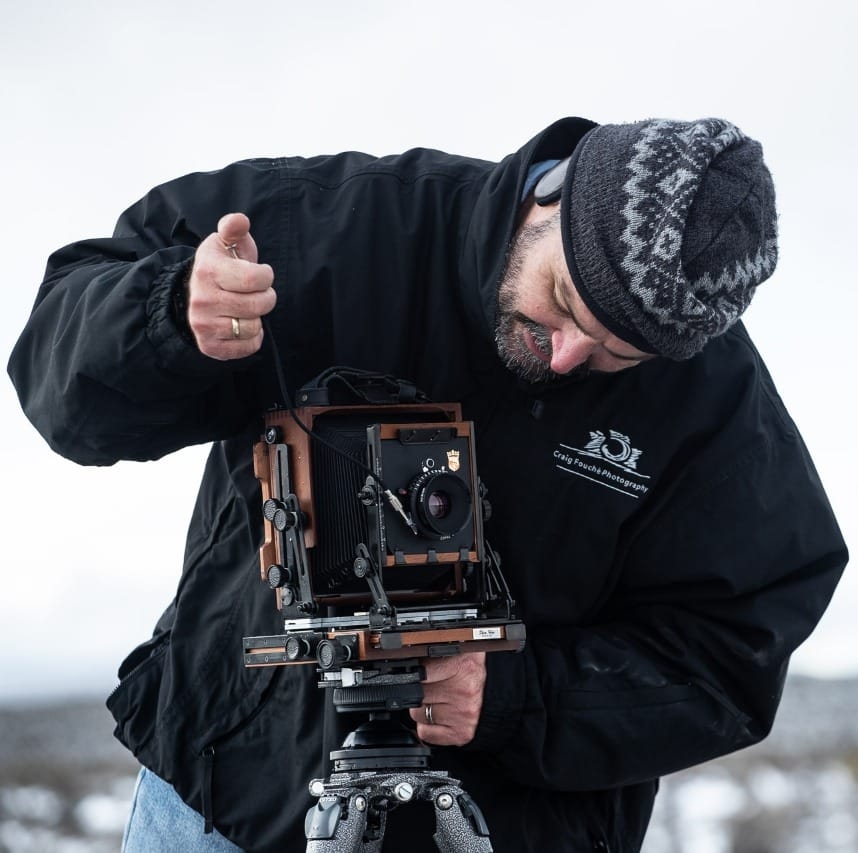
Craig Fouché, Rogge Cloof, Sutherland, South-Africa ©2020 Kirsten Frost Photography